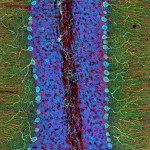Link to Pubmed [PMID] – 12218129
J. Immunol. 2002 Sep;169(6):3120-30
IFN regulatory factor (IRF)-4 is a lymphoid/myeloid-restricted member of the IRF transcription factor family that plays an essential role in the homeostasis and function of mature lymphocytes. IRF-4 expression is tightly regulated in resting primary T cells and is transiently induced at the mRNA and protein levels after activation by Ag-mimetic stimuli such as TCR cross-linking or treatment with phorbol ester and calcium ionophore (PMA/ionomycin). However, IRF-4 is constitutively upregulated in human T cell leukemia virus type I (HTLV-I) infected T cells as a direct gene target for the HTLV-I Tax oncoprotein. In this study we demonstrate that chronic IRF-4 expression in HTLV-I-infected T lymphocytes is associated with a leukemic phenotype, and we examine the mechanisms by which continuous production of IRF-4 is achieved in HTLV-I-transformed T cells. IRF-4 expression in HTLV-1-infected cells is driven through activation of the NF-kappaB and NF-AT pathways, resulting in the binding of p50, p65, and c-Rel to the kappaB1 element and p50, c-Rel, and NF-ATp to the CD28RE element within the -617 to -209 region of the IRF-4 promoter. Furthermore, mutation of either the kappaB1 or CD28RE sites blocks Tax-mediated transactivation of the human IRF-4 promoter in T cells. These experiments constitute the first detailed analysis of human IRF-4 transcriptional regulation within the context of HTLV-I infection and transformation of CD4(+) T lymphocytes.

